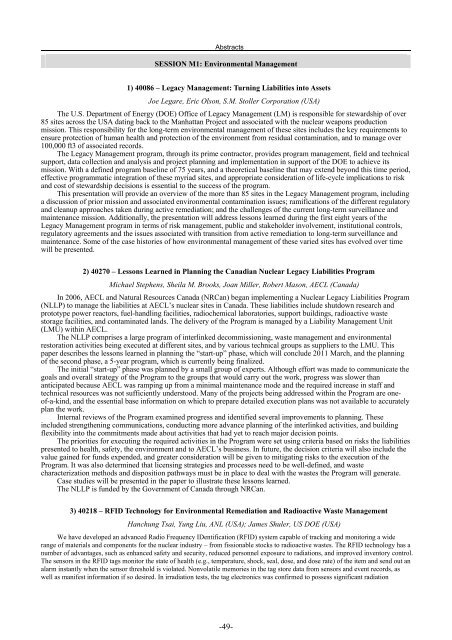ASME Message
ASME Message
ASME Message
Create successful ePaper yourself
Turn your PDF publications into a flip-book with our unique Google optimized e-Paper software.
Abstracts<br />
SESSION M1: Environmental Management<br />
1) 40086 – Legacy Management: Turning Liabilities into Assets<br />
Joe Legare, Eric Olson, S.M. Stoller Corporation (USA)<br />
The U.S. Department of Energy (DOE) Office of Legacy Management (LM) is responsible for stewardship of over<br />
85 sites across the USA dating back to the Manhattan Project and associated with the nuclear weapons production<br />
mission. This responsibility for the long-term environmental management of these sites includes the key requirements to<br />
ensure protection of human health and protection of the environment from residual contamination, and to manage over<br />
100,000 ft3 of associated records.<br />
The Legacy Management program, through its prime contractor, provides program management, field and technical<br />
support, data collection and analysis and project planning and implementation in support of the DOE to achieve its<br />
mission. With a defined program baseline of 75 years, and a theoretical baseline that may extend beyond this time period,<br />
effective programmatic integration of these myriad sites, and appropriate consideration of life-cycle implications to risk<br />
and cost of stewardship decisions is essential to the success of the program.<br />
This presentation will provide an overview of the more than 85 sites in the Legacy Management program, including<br />
a discussion of prior mission and associated environmental contamination issues; ramifications of the different regulatory<br />
and cleanup approaches taken during active remediation; and the challenges of the current long-term surveillance and<br />
maintenance mission. Additionally, the presentation will address lessons learned during the first eight years of the<br />
Legacy Management program in terms of risk management, public and stakeholder involvement, institutional controls,<br />
regulatory agreements and the issues associated with transition from active remediation to long-term surveillance and<br />
maintenance. Some of the case histories of how environmental management of these varied sites has evolved over time<br />
will be presented.<br />
2) 40270 – Lessons Learned in Planning the Canadian Nuclear Legacy Liabilities Program<br />
Michael Stephens, Sheila M. Brooks, Joan Miller, Robert Mason, AECL (Canada)<br />
In 2006, AECL and Natural Resources Canada (NRCan) began implementing a Nuclear Legacy Liabilities Program<br />
(NLLP) to manage the liabilities at AECL’s nuclear sites in Canada. These liabilities include shutdown research and<br />
prototype power reactors, fuel-handling facilities, radiochemical laboratories, support buildings, radioactive waste<br />
storage facilities, and contaminated lands. The delivery of the Program is managed by a Liability Management Unit<br />
(LMU) within AECL.<br />
The NLLP comprises a large program of interlinked decommissioning, waste management and environmental<br />
restoration activities being executed at different sites, and by various technical groups as suppliers to the LMU. This<br />
paper describes the lessons learned in planning the “start-up” phase, which will conclude 2011 March, and the planning<br />
of the second phase, a 5-year program, which is currently being finalized.<br />
The initial “start-up” phase was planned by a small group of experts. Although effort was made to communicate the<br />
goals and overall strategy of the Program to the groups that would carry out the work, progress was slower than<br />
anticipated because AECL was ramping up from a minimal maintenance mode and the required increase in staff and<br />
technical resources was not sufficiently understood. Many of the projects being addressed within the Program are oneof-a-kind,<br />
and the essential base information on which to prepare detailed execution plans was not available to accurately<br />
plan the work.<br />
Internal reviews of the Program examined progress and identified several improvements to planning. These<br />
included strengthening communications, conducting more advance planning of the interlinked activities, and building<br />
flexibility into the commitments made about activities that had yet to reach major decision points.<br />
The priorities for executing the required activities in the Program were set using criteria based on risks the liabilities<br />
presented to health, safety, the environment and to AECL’s business. In future, the decision criteria will also include the<br />
value gained for funds expended, and greater consideration will be given to mitigating risks to the execution of the<br />
Program. It was also determined that licensing strategies and processes need to be well-defined, and waste<br />
characterization methods and disposition pathways must be in place to deal with the wastes the Program will generate.<br />
Case studies will be presented in the paper to illustrate these lessons learned.<br />
The NLLP is funded by the Government of Canada through NRCan.<br />
3) 40218 – RFID Technology for Environmental Remediation and Radioactive Waste Management<br />
Hanchung Tsai, Yung Liu, ANL (USA); James Shuler, US DOE (USA)<br />
We have developed an advanced Radio Frequency IDentification (RFID) system capable of tracking and monitoring a wide<br />
range of materials and components for the nuclear industry – from fissionable stocks to radioactive wastes. The RFID technology has a<br />
number of advantages, such as enhanced safety and security, reduced personnel exposure to radiations, and improved inventory control.<br />
The sensors in the RFID tags monitor the state of health (e.g., temperature, shock, seal, dose, and dose rate) of the item and send out an<br />
alarm instantly when the sensor threshold is violated. Nonvolatile memories in the tag store data from sensors and event records, as<br />
well as manifest information if so desired. In irradiation tests, the tag electronics was confirmed to possess significant radiation<br />
-49-


